Archives
Archives /
2010
-
Inheritance with EF Code First: Part 2 – Table per Type (TPT)
In the previous blog post you saw that there are three different approaches to representing an inheritance hierarchy and I explained Table per Hierarchy (TPH) as the default mapping strategy in EF Code First. We argued that the disadvantages of TPH may be too serious for our design since it results in denormalized schemas that can become a major burden in the long run. In today’s blog post we are going to learn about Table per Type (TPT) as another inheritance mapping strategy and we'll see that TPT doesn’t expose us to this problem. Table per Type (TPT)
Table per Type is about representing inheritance relationships as relational foreign key associations. Every class/subclass that declares persistent properties—including abstract classes—has its own table. The table for subclasses contains columns only for each noninherited property (each property declared by the subclass itself) along with a primary key that is also a foreign key of the base class table. This approach is shown in the following figure: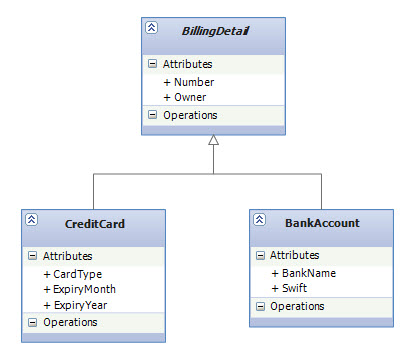
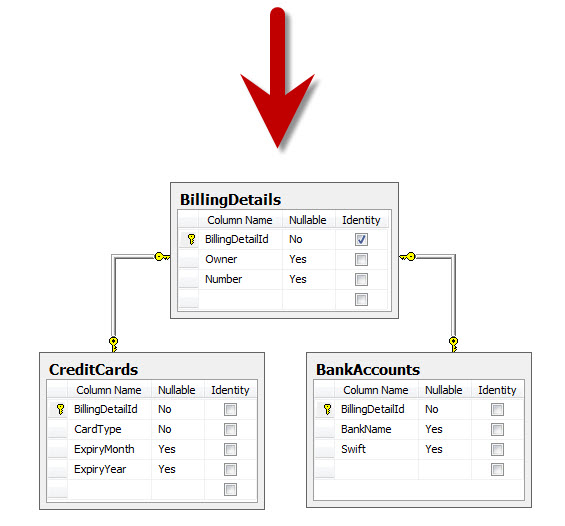
For example, if an instance of the CreditCard subclass is made persistent, the values of properties declared by the BillingDetail base class are persisted to a new row of the BillingDetails table. Only the values of properties declared by the subclass (i.e. CreditCard) are persisted to a new row of the CreditCards table. The two rows are linked together by their shared primary key value. Later, the subclass instance may be retrieved from the database by joining the subclass table with the base class table. TPT Advantages
The primary advantage of this strategy is that the SQL schema is normalized. In addition, schema evolution is straightforward (modifying the base class or adding a new subclass is just a matter of modify/add one table). Integrity constraint definition are also straightforward (note how CardType in CreditCards table is now a non-nullable column).Implement TPT in EF Code First
We can create a TPT mapping simply by placing Table attribute on the subclasses to specify the mapped table name (Table attribute is a new data annotation and has been added to System.ComponentModel.DataAnnotations namespace in CTP5):public abstract class BillingDetail { public int BillingDetailId { get; set; } public string Owner { get; set; } public string Number { get; set; } } [Table("BankAccounts")] public class BankAccount : BillingDetail { public string BankName { get; set; } public string Swift { get; set; } } [Table("CreditCards")] public class CreditCard : BillingDetail { public int CardType { get; set; } public string ExpiryMonth { get; set; } public string ExpiryYear { get; set; } } public class InheritanceMappingContext : DbContext { public DbSet<BillingDetail> BillingDetails { get; set; } }
If you prefer fluent API, then you can create a TPT mapping by using ToTable() method: protected override void OnModelCreating(DbModelBuilder modelBuilder) { modelBuilder.Entity<BankAccount>().ToTable("BankAccounts"); modelBuilder.Entity<CreditCard>().ToTable("CreditCards"); }
Polymorphic Associations
A polymorphic association is an association to a base class, hence to all classes in the hierarchy with dynamic resolution of the concrete class at runtime. For example, consider the BillingInfo property of User in the following domain model. It references one particular BillingDetail object, which at runtime can be any concrete instance of that class.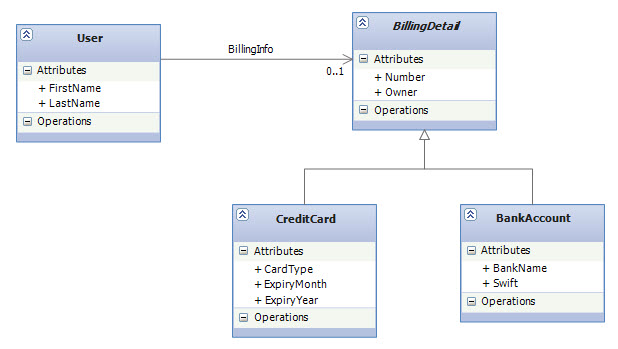
In fact, because BillingDetail is abstract, the association must refer to an instance of one of its subclasses only—CreditCard or BankAccount—at runtime. Implement Polymorphic Associations with EF Code First
We don’t have to do anything special to enable polymorphic associations in EF Code First; The user needs a unidirectional association to some BillingDetails, which can be CreditCard or BankAccount so we just create this association and it would be naturally polymorphic:public class User { public int UserId { get; set; } public string FirstName { get; set; } public string LastName { get; set; } public int BillingDetailId { get; set; } public virtual BillingDetail BillingInfo { get; set; } }
In other words, as you can see above, a polymorphic association is an association that may refer instances of a subclass of the class that was explicitly specified as the type of the navigation property (e.g. User.BillingInfo).
The following code demonstrates the creation of an association to an instance of the CreditCard subclass:using (var context = new InheritanceMappingContext()) { CreditCard creditCard = new CreditCard() { Number = "987654321", CardType = 1 }; User user = new User() { UserId = 1, BillingInfo = creditCard }; context.Users.Add(user); context.SaveChanges(); }
Now, if we navigate the association in a second context, EF Code First automatically retrieves the CreditCard instance: using (var context = new InheritanceMappingContext()) { User user = context.Users.Find(1); Debug.Assert(user.BillingInfo is CreditCard); }
Polymorphic Associations with TPT
Another important advantage of TPT is the ability to handle polymorphic associations. In the database a polymorphic association to a particular base class will be represented as a foreign key referencing the table of that particular base class. (e.g. Users table has a foreign key that references BillingDetails table.)Generated SQL For Queries
Let’s take an example of a simple non-polymorphic query that returns a list of all the BankAccounts:var query = from b in context.BillingDetails.OfType<BankAccount>() select b;
Executing this query (by invoking ToList() method) results in the following SQL statements being sent to the database (on the bottom, you can also see the result of executing the generated query in SQL Server Management Studio): 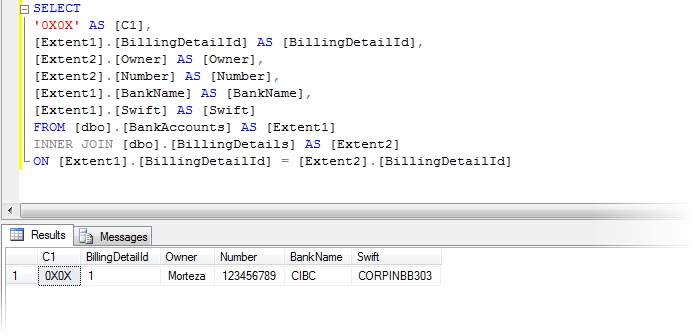
Now, let’s take an example of a very simple polymorphic query that requests all the BillingDetails which includes both BankAccount and CreditCard types: var query = from b in context.BillingDetails select b;
This LINQ query seems even more simple than the previous one but the resulting SQL query is not as simple as you might expect: 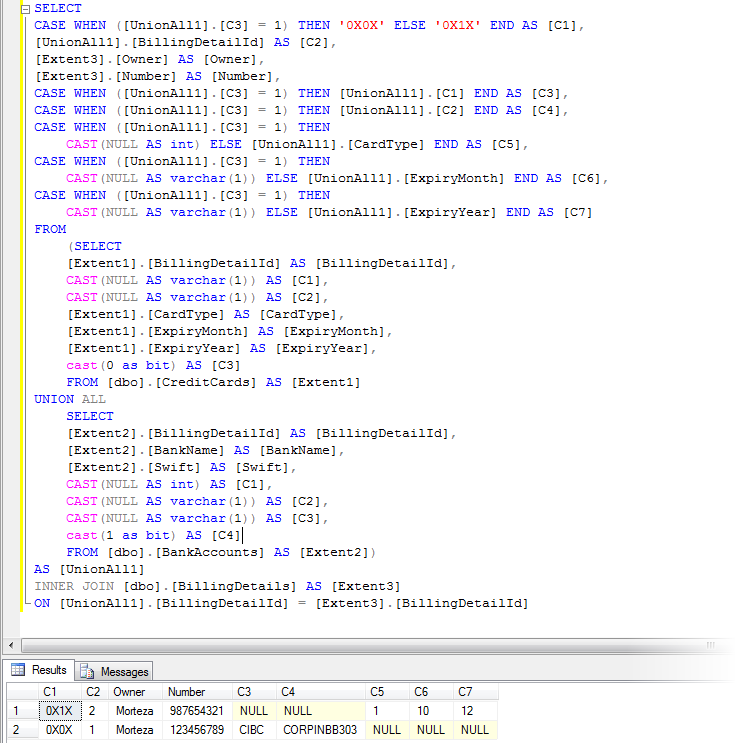
As you can see, EF Code First relies on an INNER JOIN to detect the existence (or absence) of rows in the subclass tables CreditCards and BankAccounts so it can determine the concrete subclass for a particular row of the BillingDetails table. Also the SQL CASE statements that you see in the beginning of the query is just to ensure columns that are irrelevant for a particular row have NULL values in the returning flattened table. (e.g. BankName for a row that represents a CreditCard type) TPT Considerations
Even though this mapping strategy is deceptively simple, the experience shows that performance can be unacceptable for complex class hierarchies because queries always require a join across many tables. In addition, this mapping strategy is more difficult to implement by hand— even ad-hoc reporting is more complex. This is an important consideration if you plan to use handwritten SQL in your application (For ad hoc reporting, database views provide a way to offset the complexity of the TPT strategy. A view may be used to transform the table-per-type model into the much simpler table-per-hierarchy model.)Summary
In this post we learned about Table per Type as the second inheritance mapping in our series. So far, the strategies we’ve discussed require extra consideration with regard to the SQL schema (e.g. in TPT, foreign keys are needed). This situation changes with the Table per Concrete Type (TPC) that we will discuss in the next post.
References
-
Inheritance with EF Code First: Part 1 – Table per Hierarchy (TPH)
A simple strategy for mapping classes to database tables might be “one table for every entity persistent class.” This approach sounds simple enough and, indeed, works well until we encounter inheritance. Inheritance is such a visible structural mismatch between the object-oriented and relational worlds because object-oriented systems model both “is a” and “has a” relationships. SQL-based models provide only "has a" relationships between entities; SQL database management systems don’t support type inheritance—and even when it’s available, it’s usually proprietary or incomplete.
There are three different approaches to representing an inheritance hierarchy:- Table per Hierarchy (TPH): Enable polymorphism by denormalizing the SQL schema, and utilize a type discriminator column that holds type information.
- Table per Type (TPT): Represent "is a" (inheritance) relationships as "has a" (foreign key) relationships.
- Table per Concrete class (TPC): Discard polymorphism and inheritance relationships completely from the SQL schema.
Inheritance Mapping with Entity Framework Code First
All of the inheritance mapping strategies that we discuss in this series will be implemented by EF Code First CTP5. The CTP5 build of the new EF Code First library has been released by ADO.NET team earlier this month. EF Code-First enables a pretty powerful code-centric development workflow for working with data. I’m a big fan of the EF Code First approach, and I’m pretty excited about a lot of productivity and power that it brings. When it comes to inheritance mapping, not only Code First fully supports all the strategies but also gives you ultimate flexibility to work with domain models that involves inheritance. The fluent API for inheritance mapping in CTP5 has been improved a lot and now it's more intuitive and concise in compare to CTP4.A Note For Those Who Follow Other Entity Framework Approaches
If you are following EF's "Database First" or "Model First" approaches, I still recommend to read this series since although the implementation is Code First specific but the explanations around each of the strategies is perfectly applied to all approaches be it Code First or others.A Note For Those Who are New to Entity Framework and Code-First
If you choose to learn EF you've chosen well. If you choose to learn EF with Code First you've done even better. To get started, you can find a great walkthrough by Scott Guthrie here and another one by ADO.NET team here. In this post, I assume you already setup your machine to do Code First development and also that you are familiar with Code First fundamentals and basic concepts. You might also want to check out my other posts on EF Code First like Complex Types and Shared Primary Key Associations.A Top Down Development Scenario
These posts take a top-down approach; it assumes that you’re starting with a domain model and trying to derive a new SQL schema. Therefore, we start with an existing domain model, implement it in C# and then let Code First create the database schema for us. However, the mapping strategies described are just as relevant if you’re working bottom up, starting with existing database tables. I’ll show some tricks along the way that help you dealing with nonperfect table layouts.The Domain Model
In our domain model, we have a BillingDetail base class which is abstract (note the italic font on the UML class diagram below). We do allow various billing types and represent them as subclasses of BillingDetail class. As for now, we support CreditCard and BankAccount:
Implement the Object Model with Code First
As always, we start with the POCO classes. Note that in our DbContext, I only define one DbSet for the base class which is BillingDetail. Code First will find the other classes in the hierarchy based on Reachability Convention.public abstract class BillingDetail { public int BillingDetailId { get; set; } public string Owner { get; set; } public string Number { get; set; } } public class BankAccount : BillingDetail { public string BankName { get; set; } public string Swift { get; set; } } public class CreditCard : BillingDetail { public int CardType { get; set; } public string ExpiryMonth { get; set; } public string ExpiryYear { get; set; } } public class InheritanceMappingContext : DbContext { public DbSet<BillingDetail> BillingDetails { get; set; } }
This object model is all that is needed to enable inheritance with Code First. If you put this in your application you would be able to immediately start working with the database and do CRUD operations. Before going into details about how EF Code First maps this object model to the database, we need to learn about one of the core concepts of inheritance mapping: polymorphic and non-polymorphic queries. Polymorphic Queries
LINQ to Entities and EntitySQL, as object-oriented query languages, both support polymorphic queries—that is, queries for instances of a class and all instances of its subclasses, respectively. For example, consider the following query:IQueryable<BillingDetail> linqQuery = from b in context.BillingDetails select b; List<BillingDetail> billingDetails = linqQuery.ToList();
Or the same query in EntitySQL: string eSqlQuery = @"SELECT VAlUE b FROM BillingDetails AS b"; ObjectContext objectContext = ((IObjectContextAdapter)context).ObjectContext; ObjectQuery<BillingDetail> objectQuery = objectContext.CreateQuery<BillingDetail>(eSqlQuery); List<BillingDetail> billingDetails = objectQuery.ToList();
linqQuery and eSqlQuery are both polymorphic and return a list of objects of the type BillingDetail, which is an abstract class but the actual concrete objects in the list are of the subtypes of BillingDetail: CreditCard and BankAccount. Non-polymorphic Queries
All LINQ to Entities and EntitySQL queries are polymorphic which return not only instances of the specific entity class to which it refers, but all subclasses of that class as well. On the other hand, Non-polymorphic queries are queries whose polymorphism is restricted and only returns instances of a particular subclass. In LINQ to Entities, this can be specified by using OfType<T>() Method. For example, the following query returns only instances of BankAccount:IQueryable<BankAccount> query = from b in context.BillingDetails.OfType<BankAccount>() select b;
EntitySQL has OFTYPE operator that does the same thing: string eSqlQuery = @"SELECT VAlUE b FROM OFTYPE(BillingDetails, Model.BankAccount) AS b";
In fact, the above query with OFTYPE operator is a short form of the following query expression that uses TREAT and IS OF operators: string eSqlQuery = @"SELECT VAlUE TREAT(b as Model.BankAccount) FROM BillingDetails AS b WHERE b IS OF(Model.BankAccount)";
(Note that in the above query, Model.BankAccount is the fully qualified name for BankAccount class. You need to change "Model" with your own namespace name.) Table per Hierarchy (TPH)
An entire class hierarchy can be mapped to a single table. This table includes columns for all properties of all classes in the hierarchy. The concrete subclass represented by a particular row is identified by the value of a type discriminator column. You don’t have to do anything special in Code First to enable TPH. It's the default inheritance mapping strategy:

This mapping strategy is a winner in terms of both performance and simplicity. It’s the best-performing way to represent polymorphism—both polymorphic and nonpolymorphic queries perform well—and it’s even easy to implement by hand. Ad-hoc reporting is possible without complex joins or unions. Schema evolution is straightforward. Discriminator Column
As you can see in the DB schema above, Code First has to add a special column to distinguish between persistent classes: the discriminator. This isn’t a property of the persistent class in our object model; it’s used internally by EF Code First. By default, the column name is "Discriminator", and its type is string. The values defaults to the persistent class names —in this case, “BankAccount” or “CreditCard”. EF Code First automatically sets and retrieves the discriminator values.TPH Requires Properties in SubClasses to be Nullable in the Database
TPH has one major problem: Columns for properties declared by subclasses will be nullable in the database. For example, Code First created an (INT, NULL) column to map CardType property in CreditCard class. However, in a typical mapping scenario, Code First always creates an (INT, NOT NULL) column in the database for an int property in persistent class. But in this case, since BankAccount instance won’t have a CardType property, the CardType field must be NULL for that row so Code First creates an (INT, NULL) instead. If your subclasses each define several non-nullable properties, the loss of NOT NULL constraints may be a serious problem from the point of view of data integrity.TPH Violates the Third Normal Form
Another important issue is normalization. We’ve created functional dependencies between nonkey columns, violating the third normal form. Basically, the value of Discriminator column determines the corresponding values of the columns that belong to the subclasses (e.g. BankName) but Discriminator is not part of the primary key for the table. As always, denormalization for performance can be misleading, because it sacrifices long-term stability, maintainability, and the integrity of data for immediate gains that may be also achieved by proper optimization of the SQL execution plans (in other words, ask your DBA).Generated SQL Query
Let's take a look at the SQL statements that EF Code First sends to the database when we write queries in LINQ to Entities or EntitySQL. For example, the polymorphic query for BillingDetails that you saw, generates the following SQL statement:SELECT [Extent1].[Discriminator] AS [Discriminator], [Extent1].[BillingDetailId] AS [BillingDetailId], [Extent1].[Owner] AS [Owner], [Extent1].[Number] AS [Number], [Extent1].[BankName] AS [BankName], [Extent1].[Swift] AS [Swift], [Extent1].[CardType] AS [CardType], [Extent1].[ExpiryMonth] AS [ExpiryMonth], [Extent1].[ExpiryYear] AS [ExpiryYear] FROM [dbo].[BillingDetails] AS [Extent1] WHERE [Extent1].[Discriminator] IN ('BankAccount','CreditCard')
Or the non-polymorphic query for the BankAccount subclass generates this SQL statement: SELECT [Extent1].[BillingDetailId] AS [BillingDetailId], [Extent1].[Owner] AS [Owner], [Extent1].[Number] AS [Number], [Extent1].[BankName] AS [BankName], [Extent1].[Swift] AS [Swift] FROM [dbo].[BillingDetails] AS [Extent1] WHERE [Extent1].[Discriminator] = 'BankAccount'
Note how Code First adds a restriction on the discriminator column and also how it only selects those columns that belong to BankAccount entity. Change Discriminator Column Data Type and Values With Fluent API
Sometimes, especially in legacy schemas, you need to override the conventions for the discriminator column so that Code First can work with the schema. The following fluent API code will change the discriminator column name to "BillingDetailType" and the values to "BA" and "CC" for BankAccount and CreditCard respectively:protected override void OnModelCreating(DbModelBuilder modelBuilder) { modelBuilder.Entity<BillingDetail>() .Map<BankAccount>(m => m.Requires("BillingDetailType").HasValue("BA")) .Map<CreditCard>(m => m.Requires("BillingDetailType").HasValue("CC")); }
Also, changing the data type of discriminator column is interesting. In the above code, we passed strings to HasValue method but this method has been defined to accepts a type of object: public void HasValue(object value);
Therefore, if for example we pass a value of type int to it then Code First not only use our desired values (i.e. 1 & 2) in the discriminator column but also changes the column type to be (INT, NOT NULL): modelBuilder.Entity<BillingDetail>() .Map<BankAccount>(m => m.Requires("BillingDetailType").HasValue(1)) .Map<CreditCard>(m => m.Requires("BillingDetailType").HasValue(2));
Summary
In this post we learned about Table per Hierarchy as the default mapping strategy in Code First. The disadvantages of the TPH strategy may be too serious for your design—after all, denormalized schemas can become a major burden in the long run. Your DBA may not like it at all. In the next post, we will learn about Table per Type (TPT) strategy that doesn’t expose you to this problem.
References
-
Associations in EF Code First CTP5: Part 2 – Shared Primary Key Associations
In the previous blog post I demonstrated how to map a special kind of one-to-one association—a composition with complex types as the first post in a series about entity association mapping with EF Code First. We argued that the relationships between User and Address are best represented with a complex type mapping and we saw that this is usually the simplest way to represent one-to-one relationships but comes with some limitations.
In today’s blog post I’m going to discuss how we can address those limitations by changing our mapping strategy. This is particularly useful for scenarios that we want a dedicated table for Address, so that we can map both User and Address as entities. One benefit of this model is the possibility for shared references— another entity class (let’s say Shipment) can also have a reference to a particular Address instance. If a User has a reference to this instance, as her BillingAddress, the Address instance has to support shared references and needs its own identity. In this case, User and Address classes have a true one-to-one association.Introducing the Revised Model
In this revised version, each User could have one BillingAddress (Billing Association). Also Shipment has to be delivered to an address so it always has one Delivery Address (Delivery Association). Here is the class diagram for this domain model (note the multiplicities on association lines):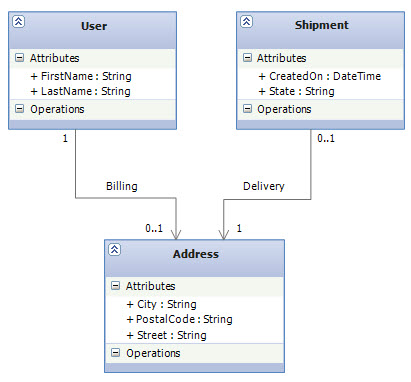
In this model we assumed that the billing address of the user is the same as her delivery address. Now let’s create the association mappings for this domain model. There are several choices, the first being a One-to-One Primary Key Association. Shared Primary Associations
Also know as One-to-One Primary Key Associations, means two related tables share the same primary key values. The primary key of one table is also a foreign key of the other. Let’s see how we map the primary key associations with Code First.How to Implement a One-to-One Primary Key Association with Code First
First, we start with the POCO classes. As you can see, we've defined BillingAddress as a navigation property on User class and another one on Shipment class named DeliveryAddress. Both associations are unidirectional since we didn't define related navigation properties on Address class as for User and Shipment.public class User { public int UserId { get; set; } public string FirstName { get; set; } public string LastName { get; set; } public virtual Address BillingAddress { get; set; } } public class Address { public int AddressId { get; set; } public string Street { get; set; } public string City { get; set; } public string PostalCode { get; set; } } public class Shipment { public int ShipmentId { get; set; } public DateTime CreatedOn { get; set; } public string State { get; set; } public virtual Address DeliveryAddress { get; set; } } public class EntityMappingContext : DbContext { public DbSet<User> Users { get; set; } public DbSet<Address> Addresses { get; set; } public DbSet<Shipment> Shipments { get; set; } }
How Code First Reads This Object Model: One-to-Many
Code First reads the model and tries to figure out the multiplicity of the associations. Since the associations are unidirectional, Code First takes this as if one Address has many Users and Many Shipments and will create a one-to-many association for each of them. So, what we were hoping for —a one-to-one association, is not inline with the conventions.How to Change the Multiplicity to One-to-One by Using the Conventions
One way to turn our associations to be one-to-one is by making them bidirectional. That is, adding a new navigation property to Address class of type User and another one of type Shipment. By doing that we basically signal Code First that we are looking to have one-to-one associations since for example User has an Address and also Address has a User. Based on the conventions, Code First will change the multiplicity to one-to-one and this will solve the problem.Should We Make This Association Bidirectional?
As always, the decision is up to us and depends on whether we need to navigate through our objects in that direction in the application code. In this case, we’d probably conclude that the bidirectional association doesn’t make much sense. If we call anAddress.User, we are saying “give me the user who has this address”, not a very reasonable request. So this is not a good option. Instead we'll keep our object model as it is and will resort to fluent API.How to Change the Multiplicity to One-to-One with Fluent API
The following code is all that is needed to make the associations to be one-to-one. Note how the multiplicities in the UML class diagram (e.g. 1 on User and 0..1 on address) has been translated to the flunet API code by using HasRequired and HasOptional methods:protected override void OnModelCreating(ModelBuilder modelBuilder) { modelBuilder.Entity<User>().HasOptional(u => u.BillingAddress) .WithRequired(); modelBuilder.Entity<Shipment>().HasRequired(u => u.DeliveryAddress) .WithOptional(); }
Also it worth mentioning that in CTP5, when we are mapping a one-to-one association with fluent API, we don't need to specify the foreign key as we would do when mapping a one-to-many association with HasForeignKey method. Since EF only supports one-to-one primary key associations it will automatically create the relationship in the database based on the primary keys and we don't need to state the obvious as we did in CTP4. Database Schema
The mapping result for our object model is as follows (note the Identity column):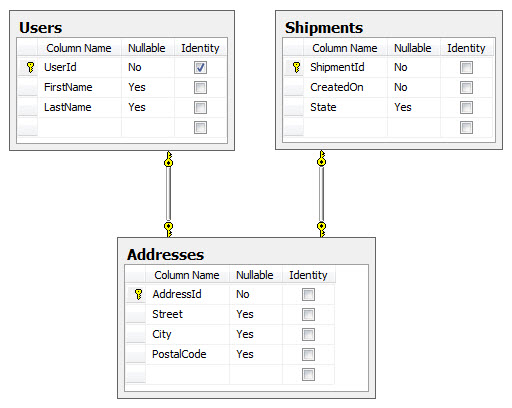
Referential Integrity
In relational database design the referential integrity rule states that each non-null value of a foreign key must match the value of some primary key. But wait, how does it even applies here? All we have is just three primary keys referencing each other. Who is the primary key and who is the foreign key? The best way to find the answer of this question is to take a look at the properties of the relationships in the database that has been created by Code First:
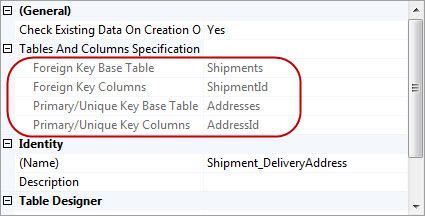
As you can see, Code First adds a foreign key constraint which links the primary key of the Addresses table to the primary key of the Users table and adds another foreign key constraint that links the primary key of the Shipments table to the primary key of the Addresses table. The foreign key constraint means that a user has to exist for a particular address but not the other way around. In other words, the database guarantees that an Addresses row’s primary key references a valid Users primary key and a Shipments row’s primary key references a valid Addresses primary key. How Code First Determines Principal and Dependent?
Code First has rules to determine the principal and dependent ends of an association. For one-to-many relationships the many end is always the dependent, but it gets a little tricky in one-to-one associations. In one-to-one associations Code First decides based on our object model, and possible data annotations or fluent API that we may have. For example in our case, we wrote this fluent API code to configure User-Address association:modelBuilder.Entity<User>().HasOptional(u => u.BillingAddress).WithRequired();This reads as "User entity has an optional association with one Address object but this association is required for Address entity."
For Code First this is good enough to make the decision: It marked User as the principal end and Address as the dependent end in the association. Since we have the same fluent API code for the second association between Address and Shipment, it marks Address as the principal end and Shipment as the dependent end in this association as well.
The referential integrity that we saw, is the first result of this Code First's principal/dependent decision.Second Result of Code First's Principal/Dependent Decision: Database Identity
If you take a closer look at the above DB schema, you'll notice that only UserId has a regular identifier generator (aka Identity or Sequence) and AddressId and ShipmentId does not. This is a very important consequence of the principal/dependent decision for one-to-one associations: the dependent primary key will become non-Identity by default. This make sense because they share their primary key values and only one of them can be auto generated and we need to take care of providing valid keys for the rest.What about Cascade Deletes?
As we saw, each Address always belongs to one User and each Shipment always delivered to one single Address. We want to make sure that when we delete a User the possible dependent rows on Address and Shipment also get deleted in the database. In fact, this is one of the Referential Integrity Refactorings which called Introduce Cascading Delete. The primary reason we would apply "Introduce Cascading Delete" is to preserve the referential integrity of our data by ensuring that related rows are appropriately deleted when a parent row is deleted. By default, Code First does not enable cascade delete when it creates a relationship in the database. As always we can override this convention with fluent API:protected override void OnModelCreating(ModelBuilder modelBuilder) { modelBuilder.Entity<User>().HasOptional(u => u.BillingAddress) .WithRequired() .WillCascadeOnDelete(); modelBuilder.Entity<Shipment>().HasRequired(u => u.DeliveryAddress) .WithOptional() .WillCascadeOnDelete(); }
What If Both Ends are Required?
We saw that the only reason Code First could figure out principal and dependent in our 1:1 associations was because our fluent API code clearly specified one end as Required and the other as Optional. But what if both endpoints are the same in terms of being required in the association? For example what if in our domain model, User always has one Address and Address always has one User (required on both end)? The answer is that ultimately, this scenario need to be configured by fluent API and the interesting point is that fluent API is designed in a way that will force you to explicitly specify who is dependent and who is principal in such cases that this cannot be inferred by Code First.
To illustrate the idea, let's see how we can configure mapping for this User-Address association (Required/Required) with fluent API:modelBuilder.Entity<User>().HasRequired(u => u.BillingAddress).WithRequiredDependent();So we invoke WithRequiredDependent() after HasRequired() method. To see the reason, we need to take a look at the RequiredNavigationPropertyConfiguration type which is returned by HasRequired(): public class RequiredNavigationPropertyConfiguration<TEntityType, TTargetEntityType> { public DependentNavigationPropertyConfiguration<TEntityType, TTargetEntityType> WithMany(); public CascadableNavigationPropertyConfiguration WithOptional(); public CascadableNavigationPropertyConfiguration WithRequiredDependent(); public CascadableNavigationPropertyConfiguration WithRequiredPrincipal(); }
As you can see, if you want to go another Required after HasRequired() method, you have to either call WithRequiredDependent() or WithRequiredPrincipal() since there is no WithRequired() method on this RequiredNavigationPropertyConfiguration class which is returned by HasRequired() method. Both WithRequired and WithOptional methods return a CascadableNavigationPropertyConfiguration type which has a WillCascadeOnDelete() method. Now if we run the code and check the database, we'll see that cascade delete on both relationships are switched on. Working with the Model
Here is an example for adding a new user along with its billing address. EF is smart enough to use the newly generated UserId for the AddressId as well:using (var context = new EntityMappingContext()) { Address billingAddress = new Address() { Street = "Yonge St.", City = "Toronto" }; User morteza = new User() { FirstName = "Morteza", LastName = "Manavi", BillingAddress = billingAddress }; context.Users.Add(morteza); context.SaveChanges(); }
The following code is an example of adding a new Address and Shipment for an existing User (assuming that we have a User with UserId=2 in the database): using (var context = new EntityMappingContext()) { Address deliveryAddress = new Address() { AddressId = 2, Street = "Main St.", City = "Seattle" }; Shipment shipment = new Shipment() { ShipmentId = 2, State = "Shipped", CreatedOn = DateTime.Now, DeliveryAddress = deliveryAddress }; context.Shipments.Add(shipment); context.SaveChanges(); }
Limitations of This Mapping
There are two important limitations to associations mapped as shared primary key:- Difficulty in saving related objects: The main difficulty with this approach is ensuring that associated instances are assigned the same primary key value when the objects are saved. For example, when adding a new Address object, it's our responsibility to provide a unique AddressId that is also valid (a User can be found with such a value as UserId.)
- Multiple addresses for User is not possible: With this mapping we cannot have more than one Address for User. At the beginning of this post, when we introduce our model, we assumed that the user has the same address for billing and delivery. But what if that's not the case? What if we also want to add a Home address to User for the deliveries? In the current setup, each row in the User table has a corresponding row in the Address table. Two addresses would require an additional address table, and this mapping style therefore wouldn’t be adequate.
Summary
In this post we learned about one-to-one associations which shared primary key is just one way to implement it. Shared primary key associations aren’t uncommon but are relatively rare. In many schemas, a one-to-one association is represented with a foreign key field and a unique constraint. In the next posts we will revisit the same domain model and will learn about other ways to map one-to-one associations that does not have the limitations of the shared primary key association mapping.
References
-
Associations in EF Code First CTP5: Part 1 – Complex Types
public class Address
{
public string Street { get; set; }
public string City { get; set; }
public string PostalCode { get; set; }
} -
My First Blog Post
Finally, here I am, starting my weblog.
My name is Morteza Manavi. I am going to blog here mostly about technologies that I am passionate about. They are Core C#, Entity Framework, WCF and ASP.Net MVC as well as software design and architecture.
A special thanks to Joe Stagner, who was kind enough to help me get this blog.